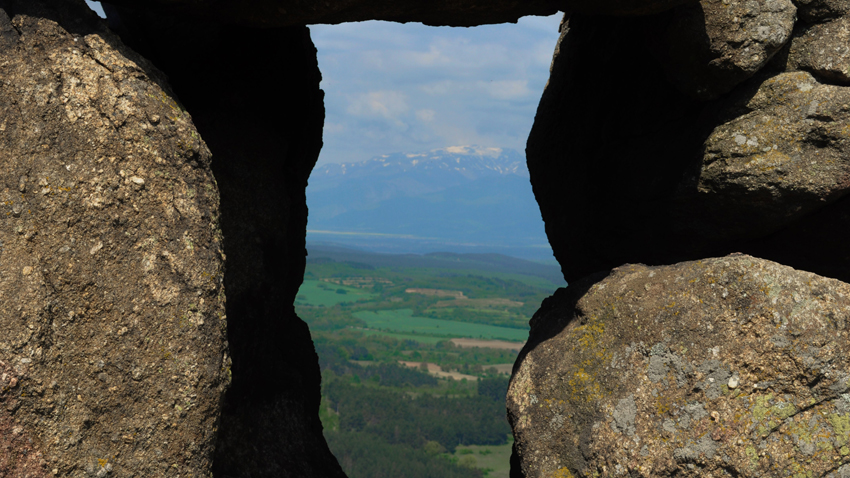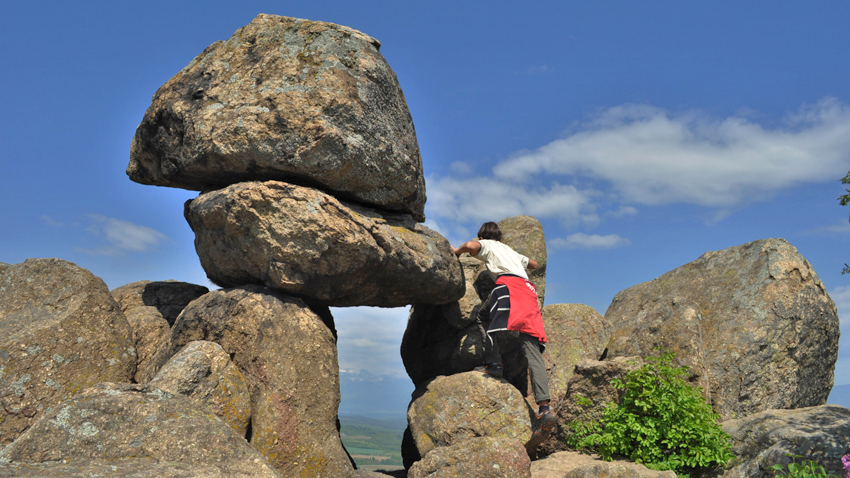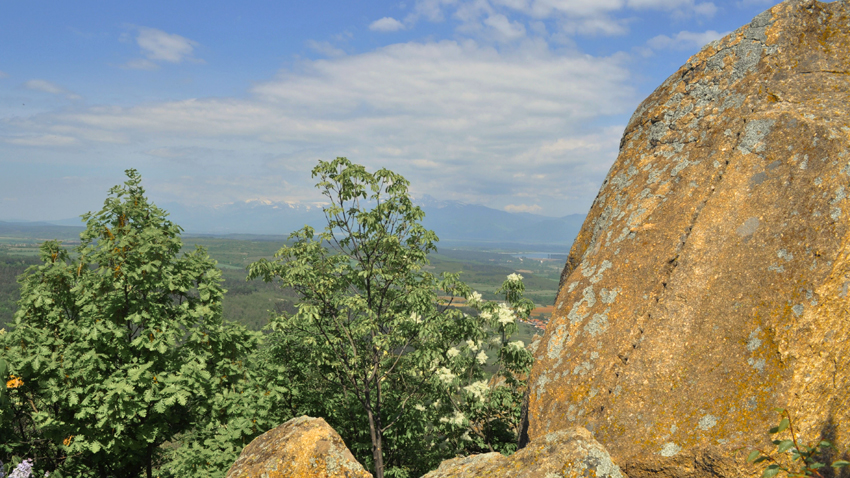Is it an ancient astronomical facility, or a random piling of giant stone blocks? Is it a sanctuary of the Thracian Odrisi tribe, or a natural phenomenon? Scientists would never reach agreement of what the so called megalith near the village of Buzovgrad, Kazanlak district, is? However, one thing is for sure - those who find themselves at the foot of the megalith would surely gasp with surprise. What power created this astonishing pile of colossal stone fragments at the edge of the abyss? Were elemental forces able to assemble this perfect construction with a square opening in the middle, or was it made by mysterious human skills in antiquity? Nowadays, this emblematic monument which hangs above a steep rock over the Rose Valley, together with several other natural landmarks in this region, is more accessible for tourists. In the autumn of 2014 an eco path leading to the mysteries of what is known as Sarnena Sredna Gora Mountain was opened.

Ancient people believed that sunrise symbolized birth and creation and sunset was a symbol of death and transition to the kingdom of the dead. Our ancestors used to build their own astronomic observatories and rock sanctuaries, where they used to meet the sun and sent prayers to their gods. Experts believe that the megalith near Buzovgrad was used for a similar purpose. A square window emerged in the central part of the stone facility through the piling of stone blocks. Thus, in the day of the summer equinox the last sunbeams pierce the rock aperture with a perfect precision. That is why the local population calls this megalith the Goddess Gate and every year on June 21 gather on that place to see the sun disc through this opening. People believe that this facility dates back to the 2nd millennium BC.
However, not all scientists share the view that this megalith is an ancient sanctuary. Some of them believe that the stone structure is merely a game of the elemental forces and product of human imagination. Deceased Bulgarian expert in Thracian studies Professor Alexander Fol saw a throne, an altar and a ravine amidst the stone pile, which were once used for religious rituals. Professor Fol believed that the megalith was situated on a triangle apex. Goliama Kosmatka Mound and the former capital of the ancient Thracian Odrisi tribe - Sevtoposis, which was engulfed by Koprinka dam, are situated on the other two apexes of the same triangle. The region is unique, it is covered with Thracian mounds and sanctuaries, Secretary of Eagles’ Nest Tourist Association in the town of Kazanlak Krastio Petkov told Radio Bulgaria. In the autumn of 2014 the village council of Buzovgrad and volunteers from the Eagles’ Nest Association made an eco path which takes visitors to the phenomenal megalith which got the nickname the Bulgarian Stonehenge. It takes an average of two and a half hours to cover the route, which includes several other historical and natural landmarks such as the Buzovo Kale Fortress which was built in Late Antiquity in the 5th-6th century AD.

“The fortress guarded the northern approach of Sredna Gora Mountain, from where people used to observe the whole Rose Valley and the passes in the opposite mountain”, Krastio Petkov explained. “This fortification was situated across the steep slope which takes people to the nearest water source at the foot of the hill. Visitors can enjoy there a very beautiful panoramic view. Traces of the so-called Tcherkovishta were also found across the region. These are Chirstian temples from the Late Antiquity with a basilica plan dating back to the 4th-6th century AD. People believe that these temples were used by the people who inhabited the lands at the foot of Sredna Gora Mountain and by the garrison which guarded the fortress. The new eco path takes visitors to the Thracian Vault containing the so-called Eshari or religious fireplaces. It consists of a corridor and funeral chamber made of granite blocks. It was discovered two years ago. Archaeologists are still working there and the place is not open for tourists. However, the trip is quite pleasant and the route reveals wonderful views towards the Rose Valley.”

The giant stone fragments scattered across Sredna Gora Mountain kindle tourists’ imagination. If people take a closer look, they would find figures resembling human faces, animals and even human organs. Some experts doubt the theories, according to which the furrows carved into the southern side of the Goddess Gate were made by our forefathers. Local people claim that they were rather made much later. “We can make similar grooves if we wedge a dry wood into the rock, thus splitting the rock in a straight line”, Krastio Petkov contends. One thing is for sure - those who decide to visit the place at sunset, climb the massive stone blocks and peer at the horizon through the stone aperture would undoubtedly feel the withering waft of eternity.
English version: Kostadin Atanasov
Photos: Veneta NikolovaLast summer, Bulgaria's coastal city Burgas and the surrounding resort towns welcomed about 600,000 Bulgarian and foreign tourists , which is 21% more than in 2023. Recently, however, Burgas has also been developing as a cultural hub, attracting more and..
The Ministry of Tourism has launched a large-scale international advertising campaign on National Geographic and 24 Kitchen channels, part of The Walt Disney Company and Warner Bros. The TV advertisement promoting Bulgaria as a destination for..
Bulgarians are traveling more and more actively and are spending more money on travel - both to nearby and distant destinations. Last year, they made about 9 million trips abroad, with neighbouring Turkey, Greece, Romania and Serbia being the most..

+359 2 9336 661
